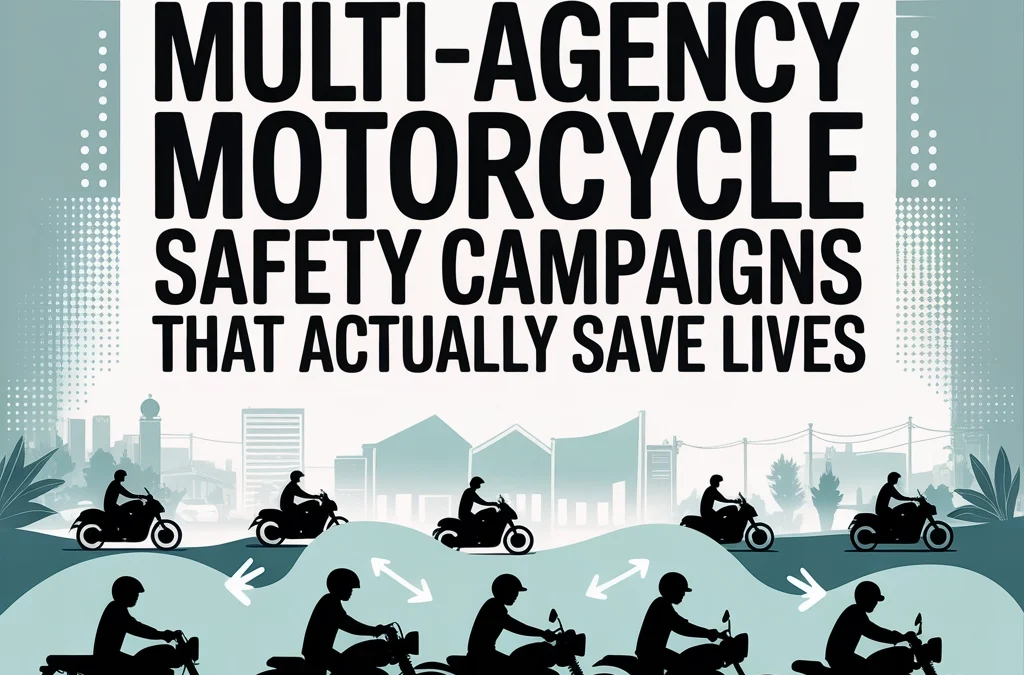Building effective multi-agency motorcycle safety campaigns requires coordinated effort across transportation departments, law enforcement, education sectors, and healthcare systems. Successful campaigns integrate evidence-based strategies, multi-channel communication approaches, and systematic evaluation methodologies using frameworks like the PDCA (plan-do-check-act) methodology to achieve measurable reductions in motorcycle fatalities.
No matter who you are or where you live, the statistics around motorcycle safety paint a sobering picture. Yet some regions are seeing dramatic improvements through well-orchestrated multi-agency campaigns that actually move the needle. The difference? These successful initiatives don't rely on generic "watch for motorcycles" messaging – they build comprehensive frameworks that unite diverse stakeholders around evidence-based interventions.
The Foundation: Multi-Sectoral Coordination
The Safe System Approach serves as the cornerstone for effective motorcycle safety campaigns. This holistic methodology recognizes that preventing crashes while minimizing their impact requires coordination across multiple sectors. Transportation departments handle infrastructure improvements, law enforcement agencies focus on compliance and emergency response, education sectors develop rider training programs, and healthcare systems provide data on injury patterns and treatment outcomes.
The most successful campaigns create formal partnerships between these agencies rather than operating in silos. Texas provides an excellent model through their Strategic Action Plan, which coordinates efforts between state transportation officials, local law enforcement, emergency responders, and community organizations. This unified approach ensures that safety messages are consistent across all touchpoints and that resources are leveraged efficiently.

Stakeholder engagement goes beyond government agencies to include motorcycle dealerships, training schools, insurance companies, and rider advocacy groups. These private sector partners bring credibility with the riding community and can amplify safety messages through trusted channels. When Harley-Davidson or Honda endorses a safety campaign, riders listen in ways they might not to government messaging alone.
Strategic Communication That Connects
Multi-channel messaging represents the backbone of effective campaigns. The Texas model demonstrates this through television public service announcements, radio spots, billboard campaigns, gas station advertising, digital platforms, and mobile advertisements. But the key lies not just in using multiple channels – it's in tailoring messages for each medium while maintaining consistent core themes.
Successful campaigns move beyond generic awareness to create emotional connections. Rather than simply reminding drivers to "watch for motorcycles," effective messaging emphasizes that motorcyclists are dads, moms, veterans, and neighbors. This humanization approach transforms abstract safety statistics into relatable personal stakes.
Real crash footage and survivor testimonials create powerful impact when paired with positive reinforcement strategies. Instead of relying solely on fear-based messaging, effective campaigns balance sobering realities with rewards for completing advanced safety courses or defensive driving programs. This carrot-and-stick approach motivates behavior change without creating campaign fatigue.
The PDCA Implementation Framework
Plan, Do, Check, Act – this internationally recognized methodology provides structure for campaign management while enabling continuous improvement. The planning phase establishes clear objectives, identifies target audiences, and maps intervention strategies across participating agencies. Too many campaigns skip this foundational work and jump straight to creative development, resulting in messaging that fails to address root causes.
During the "Do" phase, implementation must be coordinated across all participating agencies. This means synchronized launch timing, consistent spokesperson training, and shared performance metrics. The most successful campaigns designate a single lead agency to coordinate activities while respecting each partner's expertise and authority.

Checking involves more than tracking impressions or reach. Effective evaluation focuses on behavioral change indicators, crash reduction statistics, and awareness level improvements. Unfortunately, research reveals that while 36 of 44 states conduct motorcycle awareness campaigns, comprehensive effectiveness evaluations remain rare. This represents both a challenge and an opportunity for agencies willing to invest in robust measurement frameworks.
The "Act" phase closes the loop by implementing improvements based on evaluation findings. Successful campaigns scale effective interventions while discontinuing less successful approaches. This iterative process transforms one-time awareness efforts into ongoing safety improvement programs.
Six Pillars of Comprehensive Intervention
Data management forms the foundation for all other interventions. Without accurate crash data, injury statistics, and behavioral research, campaigns operate on assumptions rather than evidence. Effective programs invest in data collection systems that track both campaign performance and safety outcomes across all participating jurisdictions.
Emergency response coordination ensures that when crashes occur, victims receive optimal care quickly. This pillar often gets overlooked in awareness-focused campaigns, but it's crucial for demonstrating tangible value to emergency responders and healthcare providers who become key campaign allies.
Infrastructure improvements address environmental factors that contribute to motorcycle crashes. These might include improved road surface conditions, better sight lines at intersections, or enhanced lighting in high-crash corridors. Engineering solutions provide long-term safety benefits that complement behavioral interventions.

Awareness and education represent the most visible campaign components but must be grounded in behavioral science to be effective. Generic messaging rarely changes deeply ingrained driving habits. Successful programs use targeted approaches that address specific risk factors among identified populations.
Enforcement partnerships ensure that safety messaging is backed by consistent consequences for dangerous behaviors. When campaigns launch without coordinated enforcement efforts, they quickly lose credibility with both riders and drivers.
Vehicle safety improvements involve working with manufacturers, dealerships, and aftermarket suppliers to promote safety technologies and equipment. These partnerships can provide campaign funding while advancing mutual safety objectives.
Targeting High-Risk Populations
Young riders face heightened crash risk due to inexperience, risk-taking behaviors, and peer influence. Effective campaigns develop tailored messaging and delivery channels that resonate with this demographic. Social media platforms, gaming environments, and peer-to-peer education programs often prove more effective than traditional media approaches.
Commercial motorcycle operators represent a growing safety concern as delivery services and rideshare options expand. Campaigns must address both operator training and public awareness of increased motorcycle traffic in urban environments.
Returning riders who've taken breaks from motorcycling often overestimate their current skill levels while riding more powerful bikes than they previously owned. Refresher training programs and graduated return-to-riding protocols can reduce crashes in this population.
Technology Integration and Innovation
Digital platforms enable targeted messaging based on demographic data, geographic location, and behavioral patterns. Modern campaigns use programmatic advertising to reach specific audiences at optimal times rather than broadcasting generic messages to mass audiences.
Mobile applications can provide real-time safety information, weather alerts, and route recommendations while collecting usage data that informs future campaign development. These tools transform passive awareness campaigns into interactive safety resources.
Data analytics allow campaign managers to track performance across multiple metrics simultaneously and make real-time adjustments based on early results. Advanced analytics can identify which message combinations are most effective for specific audience segments.
Measuring Success and Continuous Improvement
Clear metrics must be established during the planning phase and tracked consistently throughout campaign implementation. Beyond traditional awareness indicators, successful programs measure behavioral change, crash reduction rates, and stakeholder engagement levels.
Longitudinal evaluation tracks safety outcomes over multiple years to account for seasonal variations and long-term trend changes. Single-year evaluations often miss important patterns and may incorrectly attribute changes to campaign interventions.
Cost-effectiveness analysis demonstrates campaign value to budget-conscious administrators and elected officials. When campaigns can show measurable safety improvements relative to program costs, they're more likely to receive continued funding and expansion approval.
The most effective multi-agency motorcycle safety campaigns combine evidence-based interventions with strategic stakeholder coordination and systematic performance measurement. By moving beyond awareness-raising to create comprehensive safety improvement programs, these initiatives achieve measurable reductions in motorcycle fatalities and injuries while building sustainable partnerships for ongoing safety enhancement.
Ready to develop a comprehensive motorcycle safety campaign for your region? Contact Dan Kost, CEO at Ride Fear Free, LLC for expert guidance on multi-agency coordination and evidence-based intervention strategies.
Connect with us:
Website: www.RideFearFree.net
Phone: +1 (970) 693-4854
LinkedIn: Connect with Dan Kost on LinkedIn
Share this post:
LinkedIn | Facebook | X | Instagram
Tags: #Motivation #Branding #Strategy #Marketing #AdvertisingAndMarketing #digitalmarketing #Innovation #Sports #MotorcycleSafety #PublicSafety #MultiAgency #CampaignDevelopment #SafetyFirst #RoadSafety

